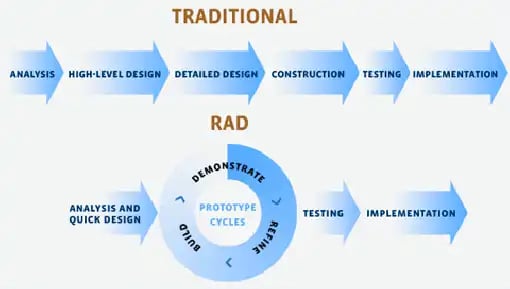Rapid Application Development vs. Agile Methodologies? You’re asking the wrong question…
There are two main approaches to successfully get you from start to finish when it comes to managing software development. These development models are known as the Agile model and Waterfall model. Each development model offers its own unique advantages and ideal use cases.
But choosing one model over the other doesn’t only change the journey—it affects the destination. Recent studies have revealed that Agile projects developed significantly higher success rates when compared to their Waterfall counterparts. Which explains why businesses are increasingly making the switch from Waterfall to Agile.
[Application Lifecycle Management]
RAD or Agile We’ll Help You Supercharge Your Software Development
Shorten release cycles without sacrificing testing or your product
Download eBook
Clearly, then, Agile is the way to go—right?
Before we wash our hands of this topic altogether, we need to ask ourselves one pertinent question: “Which Agile method?” There are more than 50 Agile methodologies to choose from. Some of the more household names include Scrum, Lean, Kanban, and Crystal. However, in this article, we focus on the method that gave birth to the Agile Model: Rapid Application Development (RAD).
Below, we discuss the Rapid Application Development vs. Agile methodologies debate, their advantages and disadvantages, and how the RAD and Agile models compare overall.
What Is the Rapid Application Development (RAD) Methodology?
What Is RAD?
RAD is a highly effective approach to project management based on iteration rather than rigid planning. James Martin first developed it as an alternative to the Waterfall method.
The motivation for a new approach was obvious. While Waterfall was perfectly suited to traditional engineering projects—projects that were both predictable and could be completed in a step-by-step fashion—software engineering had far too many unknowns to contend with.
Waterfall vs RAD
The Waterfall method is exactly that: A cascade of tasks, one flowing sequentially into the next along the lines of Design, Develop, Test, Deliver. As a result, clients would be kept in the dark until the moment the final product was revealed. This left much to be desired. If a client was unsatisfied, immense efforts were required to resolve even the smallest of issues.
And then RAD came along. Instead of presenting the client with a finished product, functional prototypes were shared on a regular basis; instead of a strict process structure, flexibility was favored; instead of a linear approach, the focus was placed on continuous iteration.
Development teams worked in collaboration with their clients. They gathered valuable user feedback, tweaked the software accordingly, tested the code, and repeated the cycle until each component was ready. Code could also be reused in new components. The result? Happier clients, increased transparency, faster deployment, and a scalable product.
The 5 Steps of the RAD Approach
Though it varies, here are the five general steps of the RAD model.
- Step 1: Define Project Requirements
Defining project requirements is a collaborative effort. It allows the client/stakeholders to discuss each facet of the project with the dev team. - Step 2: Prototyping
Designers and developers work alongside their clients to generate a minimum viable product (MVP) that can be adapted and improved over multiple iterations. - Step 3: Testing
At this point, developers will search the program for bugs, errors, and vulnerabilities. - Step 4: Feedback
With the working prototype in hand, the team will submit it to the client for feedback. - Step 5: Present Application
Before the product is deployed, the team will instruct the client on how to use the application.
%20vs.%20Agile.webp?width=850&name=Rapid%20Application%20Development%20(RAD)%20vs.%20Agile.webp)
Source: kissflow
Call-out/Tip
In the RAD model, steps 2, 3, and 4 represent what’s known as the Prototype Cycle. Contrary to Waterfall’s linear approach, the iterative nature of the Prototype Cycle makes RAD well-suited to larger projects that require careful attention to detail, built-in scalability, and continuous feedback.
Learn how you can build a software development phase in your application's lifecycle that incorporates a prototype cycle for a more robust software application.
Learn More
The RAD Approach: Pros and Cons
Let’s check out some of RAD’s pros and cons.
Pros
- Sudden changes and adaptations can easily be accommodated
- Fast iterations streamline workflow and reduce delivery time
- Collaboration better ensures client satisfaction
- Vulnerabilities are minimized through early and ongoing testing
- Code is reused, reducing testing time
- Runs on a leaner dev team than other methodologies
- Lower risk and improved scope
Cons
- Extensive collaboration can create roadblocks and confusion
- Requires a high level of programming experience
- Not suited to small projects
- Decisions can cause bottlenecks in the event of disagreements
- Requires a larger workforce outside of the primary team
- Higher cost due to experienced staff, modeling, and automated code generation
What Is Agile Methodology?
What Is Agile Software Development?
When it comes to project management systems that deliver fast, flexible, and scalable results, the Agile model is unmatched. Clients play an active role in the finished product, ensuring their own satisfaction. Meanwhile, teams work with minimum viable products (MVP) to build working components that can be easily tested and adjusted.
The Agile development model evolved out of RAD as an iterative approach. It’s, therefore, best suited to projects whose value depreciates with time, putting deployment on a tight deadline. Similarly, larger projects requiring frequent alterations are good candidates for the Agile model.
What Is the Agile Sprint System?

Source: ResearchGate
In the Agile model, big initiatives are broken down into epics; epics are broken down into user stories, and user stories are assigned as tasks and attacked in sprints. A sprint usually lasts between one and four weeks.
Sprints begin with each team member receiving a “To Do” task from the chosen Agile model (Scrum/Kanban) board. Assigned tasks are considered “In Progress.” Daily accountability meetings are held to ensure everyone stays on top of their work; team members present what they accomplished yesterday, what they intend to do today, and any challenges they’re facing.
At the end of a sprint cycle, team members submit their finished components in working order. These components are now moved to the “To Verify” phase and submitted to the client for feedback. If approved, the task gets moved to the “Done” pile; if not, it restarts the build-test-feedback karmic loop.

The Agile Approach: Pros and Cons
Because the Agile development method is derived from RAD, the advantages and disadvantages are similar.
Pros
- Rapid prototype generation lets developers accommodate changes
- Early testing provides valuable insight into errors, bugs, and vulnerabilities
- Frequent developer workshops keep the project on track
- Iteration makes the finished product both flexible and scalable
- Short development cycles translate to a faster turnaround time
- Less expensive than RAD due to smaller teams
Cons
- Requires highly trained experts
- Minimal planning and lack of documentation can lead to confusion
- Requires a high degree of collaboration between departments, in addition to the client
- Not suited to small projects that cannot be broken down
Agile vs. RAD: Which Is Right for You?
RAD vs. Agile: Which Development Process Is Better Suited for You?
It’s clear that the Rapid Application Development vs. Agile dichotomy is somewhat misleading. Both approaches are based on shared principles and offer many overlapping benefits. Both embody a philosophy of speed and parsimony. Both deliver high-quality products by beginning with simple iterative components. All this—is bolstered by continuous testing and user feedback.
Unlike Waterfall, RAD and Agile decrease risk, reduce delivery time, and increase software scalability. If you’re still unsure of how to approach application development, it may be worth exploring other iterative models.
For example, consider the Spiral model. This software development methodology boasts longer iteration cycles and a greater focus on risk assessment and management.
Get Your Software Out the Door Faster (and Get Better Return on Your Investment)
Do you find your users’ needs have changed by the time your organization’s completed the development project? Application lifecycle management can make your development process more flexible and reveal opportunities to expand functionality after deployment. Find out how we can help you streamline application development and maximize ROI.
Learn how you can better meet your users’ expectations, keep the application relevant for longer, and grow revenues with ALM and Spatial’s 3D SDKs.

